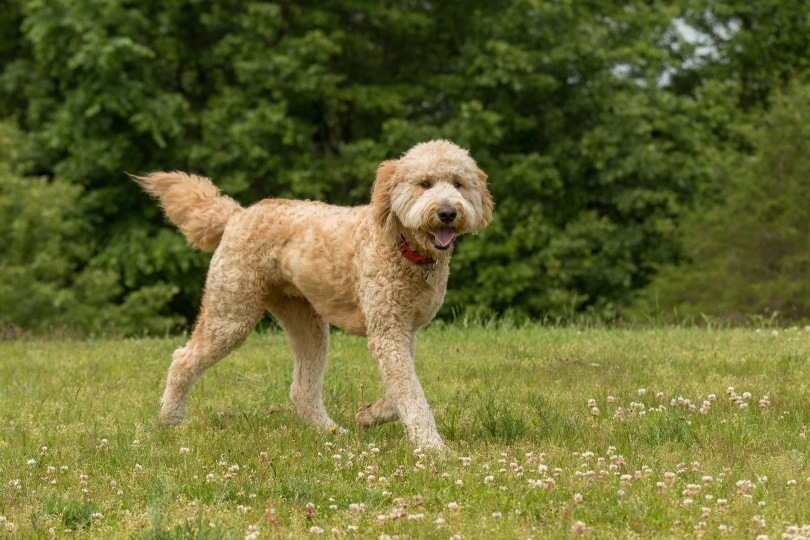Click to Skip Ahead
Goldendoodles are known as a designer dog breed. A designer dog breed mixes two purebred dogs. In this case, the Golden Retriever and the Standard Poodle are mixed to produce the Goldendoodle. Goldendoodles are loyal, affectionate, social, intelligent, and have a long lifespan of 10 to 15 years, so strap in and let’s explore this hybrid mixed breed of dog.

What’s the Average Lifespan of a Goldendoodle?
The average lifespan of a Goldendoodle is 10 to 15 years. The Standard Poodle averages anywhere from 12 to 15 years of age, and Golden Retrievers average around 10 to 12 years of age, leaving the Goldendoodle’s lifespan to fall in between their ancestors.
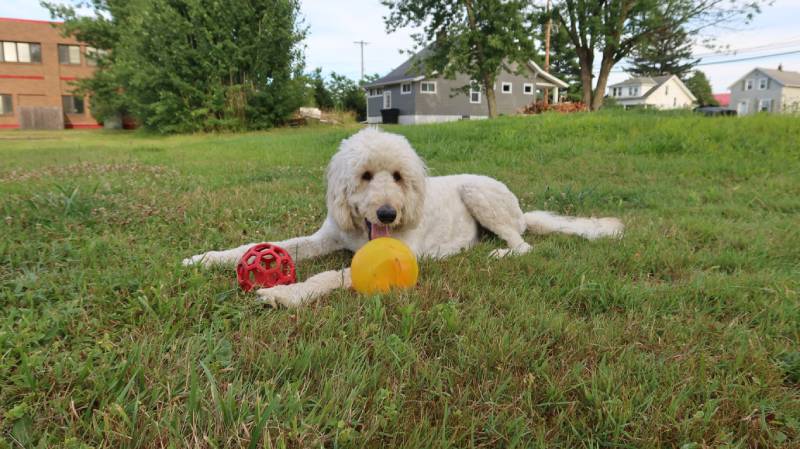
Why Do Some Goldendoodles Live Longer Than Others?
Many factors come into play and influence the Goldendoodle’s longevity. As with any dog, some live longer than others, so let’s take a closer look at possible reasons.
1. Nutrition/Weight Management
Goldendoodles require a high-quality, high-protein diet, preferably dry kibble. A good quality, fresh lean protein should be the first listed ingredient, such as chicken, turkey, or fish, and make sure you get the right kibble for the life stage your doodle is in. For example, some food is not recommended for puppies, so be sure to read the labels. Goldendoodles are prone to hip dysplasia, and feeding a commercial dog food that has glucosamine and chondroitin will aid in keeping your Goldendoodle‘s joints healthy. Also, avoid foods that have artificial flavors, preservatives, or fillers, such as soy and corn.
Obesity in dogs can lead to a whole slew of health problems and shorten their lives, such as cancer and cardiovascular disease. A good rule of thumb is to feed your doodle at specific times of the day instead of leaving food out continually. Typically, your doodle will eat 1 to 4 cups a day (depending on size and life stage) that you can divide into two feedings. That way, you can monitor precisely how much your doodle is eating to ensure proper weight management. If ever in doubt on how much to feed for optimal nutrition, consult with your veterinarian.

2. Health Conditions
No dog is free from possible health conditions, and the Goldendoodle is no exception. While reputable breeders try to breed out such conditions, they can still arise. Goldendoodles are an overall healthy hybrid breed, but they can inherit certain health conditions from their parent breeds, such as hip and elbow dysplasia, aortic/subaortic stenosis, Addison’s disease, bloat, and thyroid disease. Maintaining a healthy weight is vital for a healthy life and keeping these conditions at bay.
3. Exercise
We all know how a daily exercise routine benefits us humans, but it applies to our dogs, too! Goldendoodles love to go on runs or hikes. They also love to swim, which is something inherited from their Golden Retriever parents. Swimming is an excellent form of exercise and will keep your Goldendoodle in shape, both mentally and physically.
You’ll need to devout at least 30 minutes of exercise a day for your Goldendoodle, but preferably 1 to 2 hours a day for adults. Forms of exercise can be playing fetch, going on a walk, a run, or of course, swimming. A fenced yard is ideal because your Goldendoodle will love to play fetch with you. Goldendoodles have a lot of energy and can get bored with the same routine. With that in mind, try mixing up playtime activities and exercise. Goldendoodles are highly intelligent, making puzzle toys or a game of tug-of-war wonderful for mental stimulation. If you exercise your Goldendoodle, both physically and mentally, they will live healthier, longer lives.
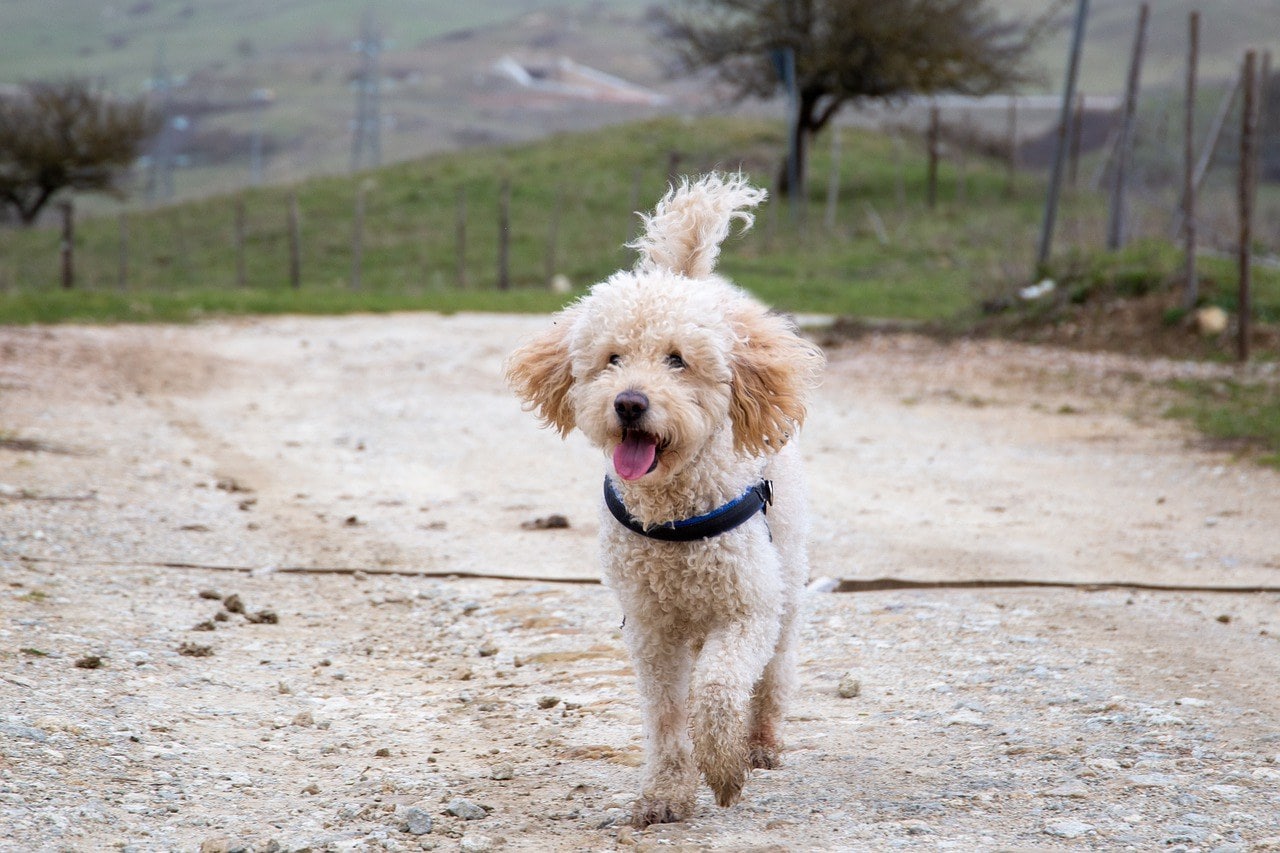
4. Size
One size fits all doesn’t apply to Goldendoodles. The smallest is the Toy Goldendoodle, which averages 10 to 25 pounds. Miniature Goldendoodles range from 25 to 35 pounds; Medium Goldendoodles range from 35 to 50 pounds and the Standard Goldendoodle averages between 50 to 90 pounds. Typically, smaller dogs tend to live longer, so it will probably have a longer lifespan if your Goldendoodle is more petite.
5. Sex
As mentioned, Goldendoodles are an overall healthy hybrid breed, but they are not immune to certain health conditions, especially females. Females are more prone to uterine cancer and mammary tumors, making getting them spayed important for their overall health. Females also deal with heat cycles and mood swings, so spaying your female is an excellent way to prolong her life.
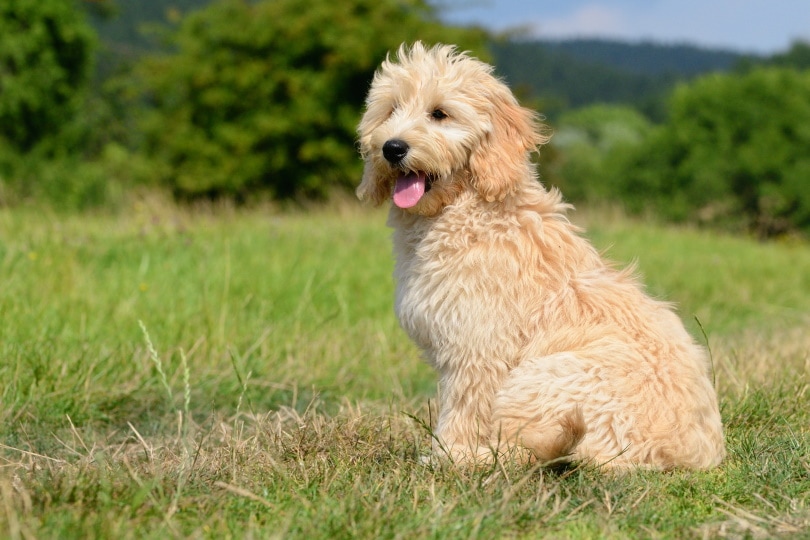
6. Genes
Genes play a significant factor in the Goldendoodle’s lifespan. Golden Retrievers don’t have as long of a lifespan as Poodles, so the more genes the Goldendoodle has of the Poodle, the longer the lifespan. However, there’s no real way to tell how many genes your doodle has of their parent breed; the breeder can only make an educated guess.
Another factor is the breeder. As we’ve mentioned, reputable breeders will try to breed out genetic health conditions by ensuring the parents have no issues before breeding, therefore, producing a healthy dog. It’s important to adopt your Goldendoodle from a reputable breeder to ensure maximum health for your new canine friend.
7. Breeding History
Crossbreeding of Golden Retrievers and the Standard Poodle started in 1969 and boomed in the 1990s in the United States and Australia. The original purpose was to produce a hypoallergenic and guide dog for the disabled allergy sufferer. Poodles do not shed much, so they don’t produce dander like most dogs. Guide dogs should be easily trainable and gentle, and that’s where the Golden Retriever comes in. Given the lifespans of the two parent breeds, Goldendoodles gain the advantage of having relatively long lives.
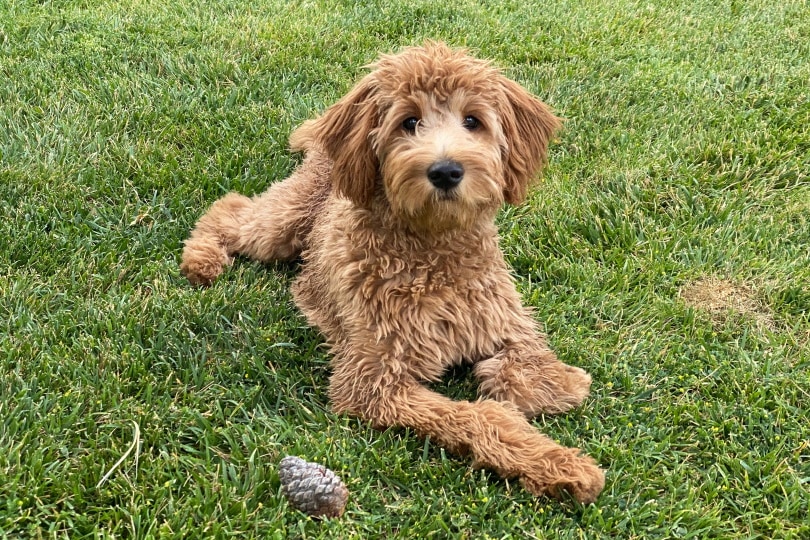
8. Dental Hygiene
Let’s face it—most dogs don’t care for getting their teeth brushed, but good dental hygiene is such a vital component in a dog’s overall health. Dental disorders, such as gum disease and periodontitis, can cause your doodle health problems if left untreated. Goldendoodles love games, so come up with a fun way to brush. Try showing them the toothbrush, and when they show interest, give them a little treat. It’s all about slowly progressing to actual brushing. With patience, your doodle will more than likely allow it. Try to aim for 2 to 3 times per week, but generally speaking, brush their teeth as often as you can.
The 4 Life Stages of a Goldendoodle
Puppy Stage

Bringing a new puppy home is both exciting and a little frightening, especially if you have no idea what to expect. Your puppy doodle will probably be around 8 weeks of age when you bring it home. As with any puppy, they’ll be curious about all things. Puppy proofing your home is important, such as putting hazardous items out of reach and away and making sure there are no places your doodle can escape from the yard. Providing plenty of safe chew toys is a good idea and taking them outside to potty multiple times a day is also ideal.
The puppy stage is the critical time for training. Goldendoodles are highly intelligent, thanks to the smart genes passed down from their parents, but they still need training from you. Teaching them basic commands, like “sit,” “stay,” or “down,” goes a long way and introduces them to discipline.
Your puppy will be in the development stage, so limiting exercise time is important to prevent overexertion. At 3 months, aim for about 5 minutes of play twice a day. Don’t overdo it; their developing joints will be fragile, and they’ll lack a lot of stamina. As they grow, slowly increase playtime increments; at 3 months, 15-30 minutes a day, 4 months, 20-40 minutes, 5 months, 25-45 minutes, and 6 months, 30-60 minutes a day. Also, consider spaying/neutering your pup at 6 months of age.
As far as nutrition, feed you doodle pup kibble formulated specifically for puppies, preferable a large-breed puppy food. You can also check with your vet on how much to feed to ensure they’re getting the right amount of nutrition during this critical stage. You can go by the directions on the bag but consult with your vet to be safe.
Young Adult
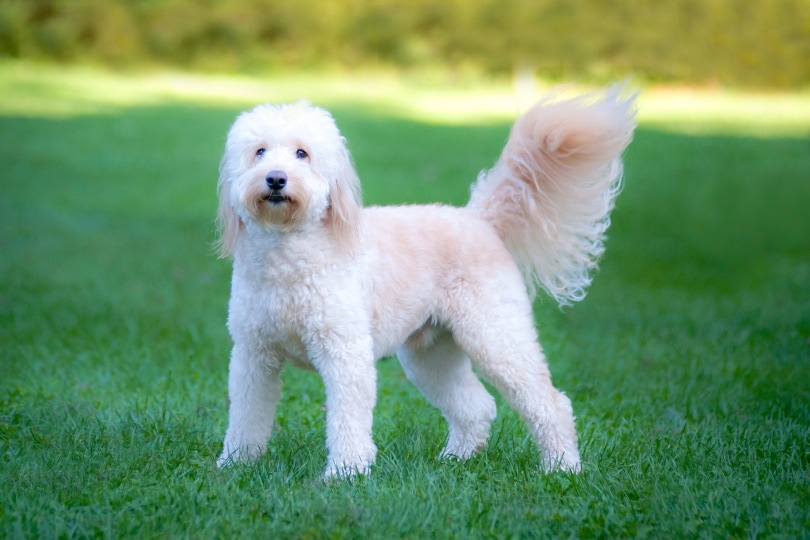
Your Goldendoodle will reach maturity at around 8-12 months of age. Your doodle will keep growing at this age, usually reaching full-grown size at about 2 years old. Keep in mind, though, that they will continue to grow at this stage mentally.
They will need a lot of exercise at this stage and continual training to ward off unwanted behaviors, such as destroying a roll of toilet paper or getting into the trash. Positive reinforcement is the key to successful training. You’ll want to be firm, but not so much that your doodle will become afraid of you. Remember, Goldendoodles are highly intelligent, and they’ll get the gist quickly with persistence.
You’ll want to change their food from puppy to adult food, but don’t do it all at once. The best way to avoid tummy upset is to gradually replace the old food with the new. Start by giving ¾ cup of puppy food and ¼ cup of new food for 3 to 4 days. Then, ½ cup of puppy food and ½ cup of new food for 2-3 days, followed by ¼ cup puppy food and ¾ cup of new food for 2-3 days. After that, they should be good to go exclusively eating their new food.
Mature Adult
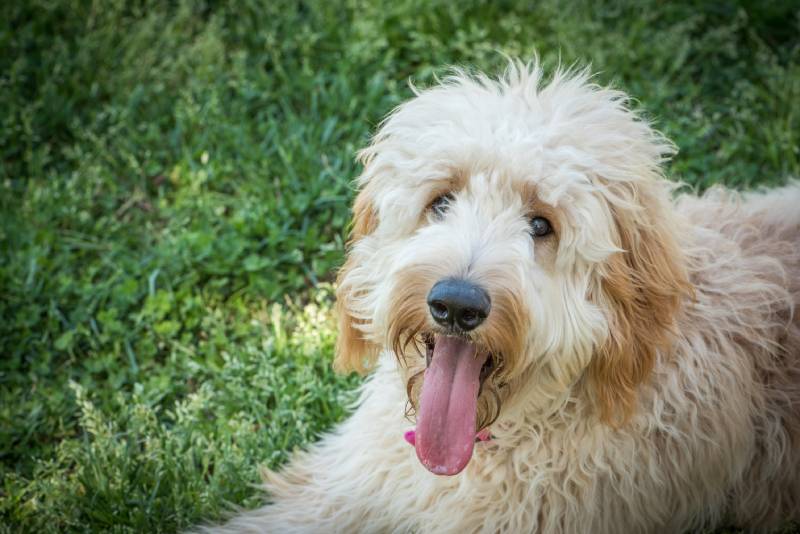
By the time your doodle reaches this stage, they should be in a routine and know their place in the pack within your household. They will have stopped growing at this point but still have relatively high energy. You will, however, notice that they will be a little calmer than they were as a young adult.
Your doodle will need around 30 minutes of exercise a day at this point, split up into two sessions. Going for a walk or a trip to the dog park will suffice, or maybe even a quick dip since they love to swim.
Senior
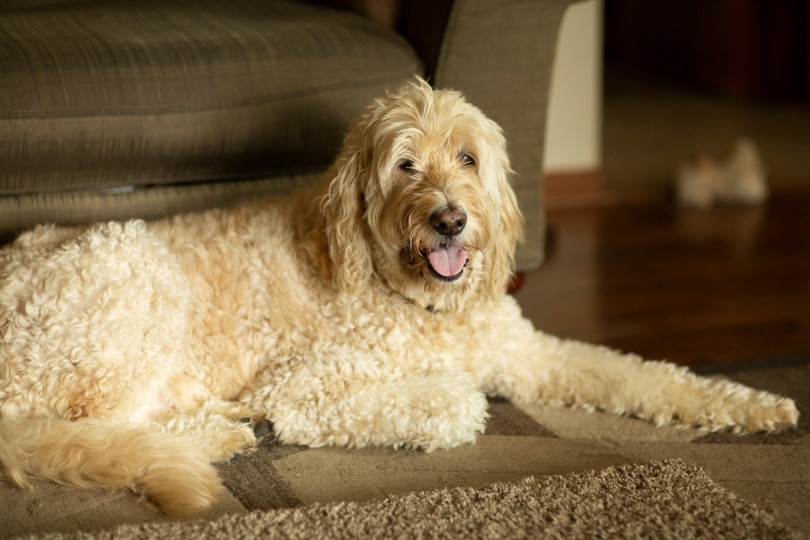
This stage is where you’ll want to monitor your doodle, especially during exercise. They’ll begin to show signs of aging, such as grey hairs sprouting up on the face and getting up slower than they used to. Make sure to take them for regular checkups, and, at this point, you’ll probably want to change their food to a senior food that supports joint health. Keep their mind active with mental stimulation, and don’t overdo it with exercise.
It’s important to give them around 30-45 minutes of gentle exercises, such as a walk or a little swim. At 7 to 9 years of age, they will likely slow down a bit, and it’s a good idea to keep an eye out for any mobility issues, such as limping or behavioral changes. You’ll know your doodle the best, so if you feel your doodle isn’t feeling 100%, have your veterinarian do a checkup.
How To Tell Your Goldendoodle’s Age
If you adopted your Goldendoodle and have no idea how old it is, there are ways and clues to get an idea. Your vet can assist in this task by doing an examination. The shape the teeth are in gives a good indication too. Young pups that are 1-2 years old will still have clean, white teeth. By 3 and 5 years of age, you may notice signs of tarter and wear and tear. By 5 to 10 years of age, signs of disease may be present. By 10 to 15 years of age, teeth may be missing, and the teeth will be worn.
- Related Read: 20 Designer Dog Breeds
Conclusion
Goldendoodles make excellent companions and family pets. They live relatively long lives and will bring you many years of joy. Be sure to give them the appropriate amount of exercise and take them for yearly checkups. Feed them high-quality food and brush their teeth as often as you can. In doing these things, your doodle will be a happy, healthy dog for years to come.
Featured Image Credit: Jennifer McCallum, Shutterstock

